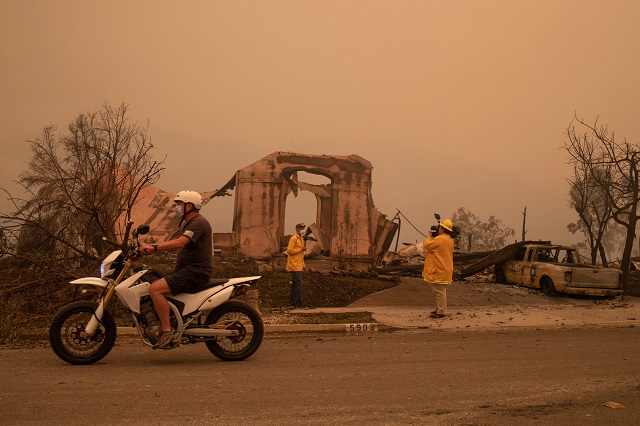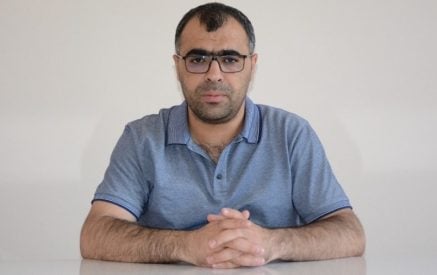By Lucy Westcott/James W. Foley Emergencies Research Associate
In this unforgettably tumultuous year, journalists across the world covered the ongoing pandemic, dangerous protests, natural disasters, active conflicts, elections, and other life-changing events. The reporters, anchors, photographers, camera operators, producers, and technicians who brought 2020’s biggest stories to the public often risked their own physical safety and psychological well-being and found themselves the subjects of increased digital abuse.
In 2020, CPJ’s Emergencies team supported an unprecedented number of journalists, many of whom covered multiple high-risk stories at once. CPJ assisted more than 750 journalists through emergency grants, one-on-one safety consultations, webinars, and advice on personal protective equipment (PPE). Here are some of the biggest news stories of the year, the biggest safety issues facing journalists, and what CPJ did to assist.

A video journalist with Swiss public broadcasting films at the care unit for patients infected by COVID-19 at the hospital of La-Chaux-de-Fonds on November 5, 2020. (AFP/Fabrice Coffrini)
Journalists covering the COVID-19 pandemic had to quickly figure out how to protect themselves from the virus while covering the biggest news story in a generation. Early on, reporters told CPJ about creative ways they found to stay safe, like configuring a makeshift sink on the trunk of a car to allow for on-the-go handwashing, and the challenges they faced while reporting on COVID-19 in Rio’s favelas or amid ongoing restrictions in Kashmir.
Read also
CPJ published its first version of the COVID-19 safety advisory in February. Our safety experts frequently updated it throughout the year as the virus and global reactions to it changed. CPJ also provided best practices on covering U.S. anti-lockdown protests, which were also held in other places around the world.
Physical safety wasn’t the only concern for reporters covering COVID-19: one-fifth of journalists who responded to an October survey from the International Center for Journalists (ICFJ) said their experience of online harassment was “much worse” during the pandemic. The survey also found that 70 percent of journalists said the psychological and emotional impacts of dealing with the COVID-19 crisis has been the most difficult aspect of their work during the pandemic.

Members of media take pictures of anti-government protesters in Bangkok, Thailand, October 18, 2020. Picture take October 18, 2020. REUTERS/Athit Perawongmetha – RC2ILJ9NTGU9
Protests raged across the world this year, both before and after the World Health Organization declared the coronavirus a full-blown pandemic in March. Early in 2020, CPJ published safety advisories for protests in Iraq, India, and Lebanon, and more recently distributed general safety information for reporters covering the unrest in Belarus. COVID-19 brought added risks to journalists reporting on protests, where people gather close together and authorities deploy tear gas and other irritants, causing people to cough or remove masks. In November, CPJ published a comprehensive PPE glossary to help journalists identify the right safety equipment to use while reporting on high-risk stories, including protests.

A protester argues with law enforcement officers as a reporter runs away from tear gas during a demonstration against the death in Minneapolis police custody of George Floyd, in Saint Paul, Minnesota, U.S. May 31, 2020. REUTERS/Carlos Barria – RC250H9UCRUR
The death of George Floyd in Minneapolis police custody in late May set off a wave of protests across the United States which saw unprecedented attacks against journalists, mostly by law enforcement. CPJ published a safety advisory specific to the U.S. protests and the U.S. Press Freedom Tracker, of which CPJ is a founding member, is verifying more than 980 reported incidents of press freedom violations related to the protests.

Lebanese protesters clash with security forces in the vicinity of the parliament in central Beirut on August 10, 2020 following a huge chemical explosion that devastated large parts of the Lebanese capital. (Photo by IBRAHIM AMRO / AFP)
On August 4, an explosion ripped through the Beirut port, sending shockwaves through the city. The blast, caused by several thousand tons of neglected stores of ammonium nitrate, killed more than 200 people and injured more than 6,000, according to The Guardian. Journalists in Beirut, a hub for reporters in the Middle East, immediately started reporting on the story, even as some were badly injured in the blast. Some journalists who spoke with CPJ about their experience covering the explosion’s aftermath said that mental health support was critical. Reporting on the aftermath of the explosion posed a challenge for journalists, who were attacked and injured by security forces and protesters in the following days.

A man rides past journalists reporting on the aftermath of the Shady Fire after it advanced into the Skyhawk neighborhood of Santa Rosa, California, U.S. September 28, 2020. REUTERS/Adrees Latif – RC2V7J9XXR3I
Devastating wildfires burned parts of Australia, Brazil, and the western United States in 2020, and there’s evidence that they are becoming more frequent, according to Science Brief, a website that reviews peer-reviewed scientific studies on various topics, including climate change. In September, CPJ published advice on how to safely cover wildfires, which emphasized the fact the fires can quickly change and are unpredictable. CPJ’s interviews with journalists who have covered wildfires—some for decades, some for the first time in 2020—stressed the importance of wearing the right gear, and the toll that wildfire coverage can take on mental health.

Radio journalists from a local public radio work at their studio located in a basement during the military conflict over the breakaway region of Nagorno-Karabakh, in Stepanakert October 12, 2020. REUTERS/Stringer – RC23HJ9ZSJQX
In September, a six-week war broke out between Armenia and Azerbaijan over the breakaway region of Nagorno-Karabakh. At least six journalists were seriously injured while reporting on the war, as CPJ documented at the time. CPJ published a safety advisory for journalists covering the conflict. A BBC journalist who spoke with CPJ said the biggest challenge during her Nagorno-Karabakh coverage was staying safe. Her team wore bulletproof vests and helmets and tried to stay in hotels with a basement in case of shelling.

Journalists work inside designated circles to ensure social distancing as they await the arrival of Democratic U.S. vice presidential nominee Senator Kamala Harris at a campaign event in Raleigh, North Carolina, U.S. September 28, 2020. REUTERS/Jonathan Drake – RC2U7J9GLOKI
The U.S. presidential election brought its own set of reporting risks. At the start of the year, CPJ published its U.S. elections safety kit, which highlighted the risks of protests, rallies, and online and digital attacks against journalists covering the vote. The COVID-19 pandemic and ongoing protests against police brutality in the U.S. threw an element of uncertainty into the mix, as did the unusually lengthy process of state certification of the results.

Journalists are barred entry from a U.S. President Donald Trump legal team news conference after news media named Democratic presidential nominee Joe Biden the winner in the 2020 U.S. presidential election, in Philadelphia, Pennsylvania, U.S. November 7, 2020. REUTERS/Mark Makela – RC2IYJ9W60AC
The U.S. Press Freedom Tracker is documenting at least 60 reported incidents of election-related press freedom violations, including physical assaults by supporters of President Donald Trump and arrests by law enforcement. With a new administration entering the White House in January 2021, CPJ urged President-elect Joe Biden to support press freedom in the United States and appoint a special envoy for press freedom to represent his administration wherever journalists are at risk.
Lucy Westcott is CPJ’s James W. Foley Emergencies Research Associate. Prior to joining CPJ, Westcott was a staff writer for Newsweek, where she covered gender and immigration. She has reported for outlets including The Intercept, Bustle, The Atlantic, and Women Under Siege, and was a United Nations correspondent for the Inter Press Service.
Committee to Protect Journalists
Main caption: Journalists interview a man, who says he is infected with COVID-19, while he holds a protest outside the National Palace to demand the reconnection of electricity at his house in Mexico City, Mexico May 28, 2020. CPJ assisted reporters covering COVID-19 and other issues throughout the year. (Reuters/Carlos Jasso)






















































